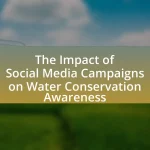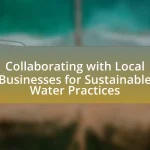The article focuses on strategies for building a water-conscious community culture, emphasizing key elements such as education, conservation practices, community engagement, and sustainable policies. It outlines methods for raising awareness about water conservation, including educational programs, local events, and the involvement of businesses. The article also discusses practical strategies for households, the role of technology in promoting conservation, and the importance of collaboration among community members and local governments. Additionally, it highlights the significance of measuring the impact of water-conscious initiatives and sustaining long-term commitment through ongoing education and outreach.
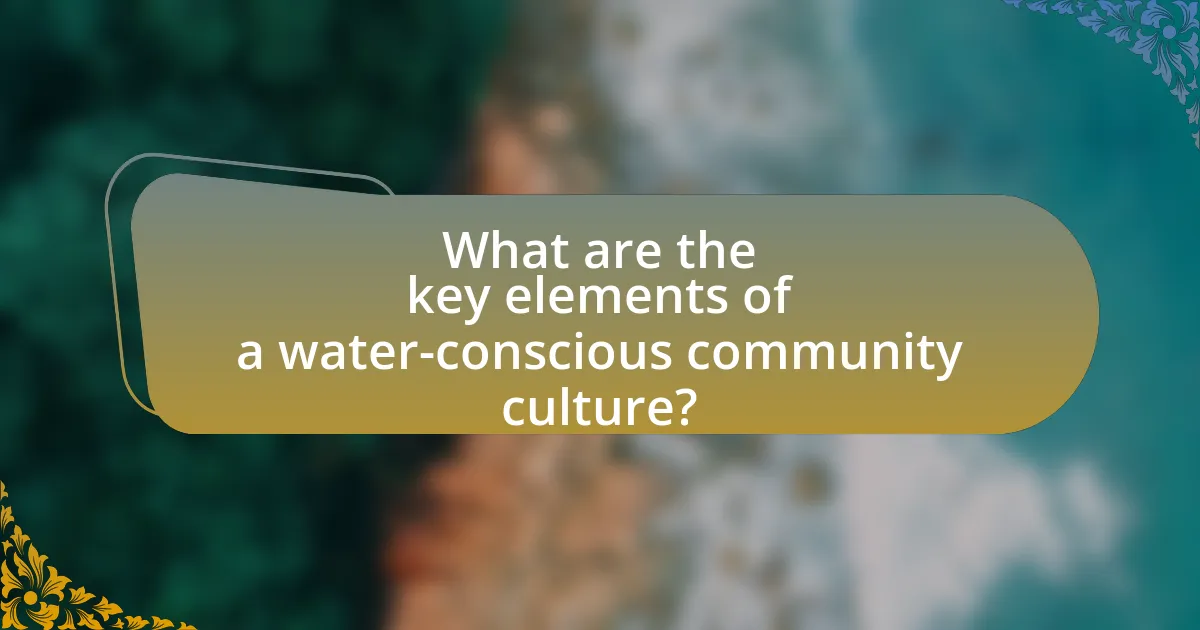
What are the key elements of a water-conscious community culture?
The key elements of a water-conscious community culture include education, conservation practices, community engagement, and sustainable policies. Education fosters awareness about water scarcity and the importance of conservation, leading to informed decision-making among community members. Conservation practices, such as rainwater harvesting and xeriscaping, reduce water usage and promote efficient resource management. Community engagement encourages participation in water-related initiatives, strengthening collective responsibility for water stewardship. Sustainable policies, such as regulations on water use and incentives for water-saving technologies, provide a framework that supports and reinforces these cultural values. Together, these elements create a cohesive approach to fostering a culture that prioritizes water conservation and sustainability.
How can community awareness about water conservation be raised?
Community awareness about water conservation can be raised through educational programs and outreach initiatives. Implementing workshops in schools and community centers can effectively inform residents about the importance of water conservation, demonstrating practical methods such as rainwater harvesting and efficient irrigation techniques. Research indicates that communities engaged in educational outreach see a 20-30% reduction in water usage, as evidenced by studies conducted by the American Water Works Association. Additionally, utilizing social media campaigns to share tips and success stories can further enhance community engagement and awareness.
What educational programs can be implemented to promote water conservation?
Educational programs that can be implemented to promote water conservation include school-based curricula focused on water management, community workshops on sustainable practices, and public awareness campaigns utilizing social media. School curricula can teach students about the water cycle, the importance of conservation, and practical measures to reduce water usage, which can lead to long-term behavioral changes. Community workshops can provide hands-on training in techniques such as rainwater harvesting and xeriscaping, which have been shown to reduce water consumption significantly. Public awareness campaigns can leverage statistics, such as the fact that the average American household uses about 300 gallons of water per day, to highlight the need for conservation efforts. These educational initiatives collectively foster a culture of water consciousness within communities.
How can local events foster a culture of water consciousness?
Local events can foster a culture of water consciousness by providing educational opportunities and engaging community members in hands-on activities related to water conservation. For instance, workshops and seminars can inform participants about the importance of water sustainability, while activities like clean-up drives or rainwater harvesting demonstrations can actively involve individuals in water-saving practices. Research indicates that community engagement through local events significantly increases awareness and behavioral change regarding environmental issues, including water conservation. A study published in the Journal of Environmental Psychology found that participatory events lead to a 30% increase in community members adopting water-saving habits.
What role does community engagement play in water conservation?
Community engagement plays a crucial role in water conservation by fostering collective responsibility and awareness among residents. When communities actively participate in water conservation initiatives, they are more likely to adopt sustainable practices, such as reducing water waste and implementing efficient irrigation systems. Research indicates that community-led programs can lead to a 20-30% reduction in water usage, as seen in various case studies across the United States. Engaging local stakeholders through workshops, educational campaigns, and collaborative projects enhances knowledge sharing and motivates individuals to take action, ultimately contributing to the preservation of water resources.
How can residents be encouraged to participate in water-saving initiatives?
Residents can be encouraged to participate in water-saving initiatives through education, incentives, and community engagement. Educational programs that inform residents about the importance of water conservation and practical methods to save water can significantly increase participation rates. For instance, studies show that communities with educational outreach programs see a 20-30% increase in water-saving behaviors. Additionally, providing financial incentives, such as rebates for water-efficient appliances or landscaping, motivates residents to adopt water-saving practices. Community engagement activities, such as workshops and local events focused on water conservation, foster a sense of collective responsibility and encourage residents to take action together.
What strategies can be used to involve local businesses in water conservation efforts?
To involve local businesses in water conservation efforts, strategies such as creating partnerships, offering incentives, and providing educational resources can be implemented. Partnerships between local governments and businesses can facilitate collaborative initiatives, such as community clean-up events or water-saving campaigns, which enhance visibility and engagement. Incentives, such as tax breaks or grants for businesses that adopt water-efficient technologies, encourage participation by reducing financial burdens. Additionally, providing educational resources, including workshops and informational materials on best practices for water conservation, empowers businesses to implement effective strategies. Research indicates that businesses engaged in sustainability practices can improve their brand reputation and customer loyalty, further motivating their involvement in water conservation efforts.
Why is collaboration important in building a water-conscious community?
Collaboration is crucial in building a water-conscious community because it fosters shared responsibility and collective action towards sustainable water management. When community members, local governments, and organizations work together, they can pool resources, knowledge, and expertise, leading to more effective water conservation strategies. For instance, a study by the Water Research Foundation found that collaborative efforts in water conservation initiatives can lead to a 20% reduction in water usage in participating communities. This demonstrates that collaboration not only enhances awareness but also drives tangible results in water conservation efforts.
What partnerships can be formed to enhance water conservation efforts?
Partnerships between local governments, non-profit organizations, and community groups can significantly enhance water conservation efforts. Local governments can implement policies and regulations that promote sustainable water use, while non-profit organizations can provide education and resources to the community. Community groups can engage residents in conservation initiatives, such as tree planting and rainwater harvesting. For example, the partnership between the City of San Diego and the San Diego County Water Authority has led to successful water-saving programs, resulting in a 20% reduction in water use since 2007. This collaborative approach leverages resources and expertise, fostering a culture of water conservation within the community.
How can local governments support community water conservation initiatives?
Local governments can support community water conservation initiatives by implementing policies that promote sustainable water use and providing resources for education and outreach. For instance, they can establish rebate programs for water-efficient appliances, which have been shown to reduce water consumption significantly. According to the American Water Works Association, such programs can lead to a 20-30% reduction in residential water use. Additionally, local governments can partner with community organizations to host workshops that educate residents about water-saving techniques, further fostering a culture of conservation. By integrating these strategies into their governance, local governments can effectively enhance community engagement in water conservation efforts.
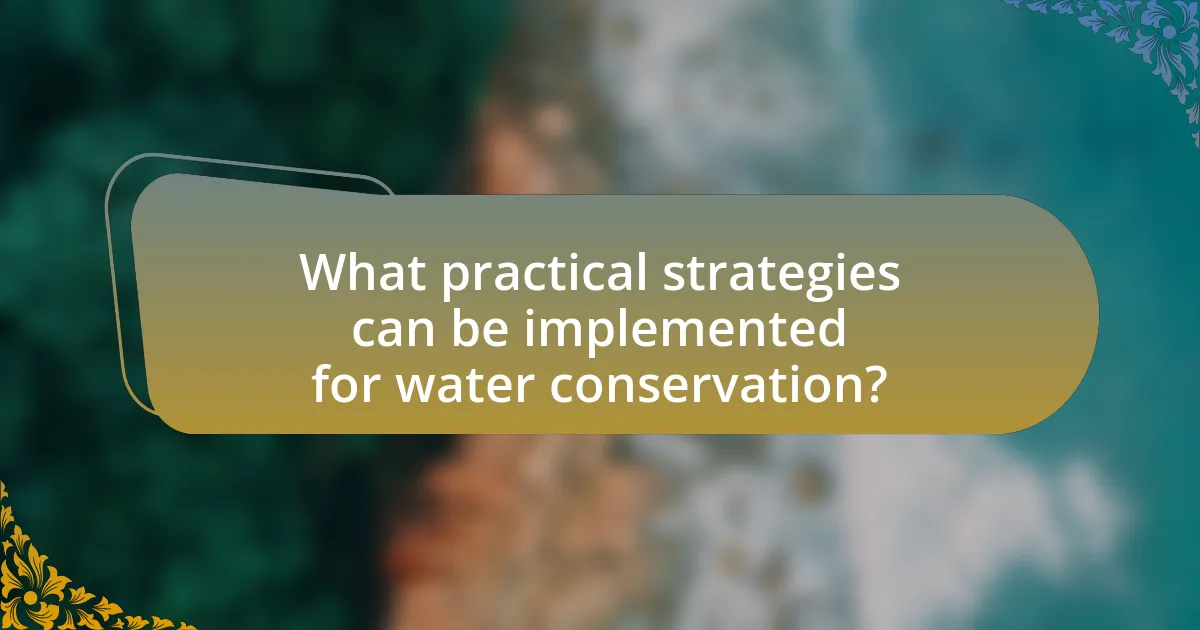
What practical strategies can be implemented for water conservation?
Practical strategies for water conservation include implementing rainwater harvesting systems, using water-efficient appliances, and promoting xeriscaping in landscaping. Rainwater harvesting captures and stores rainwater for irrigation and non-potable uses, significantly reducing reliance on municipal water supplies. Water-efficient appliances, such as low-flow showerheads and dual-flush toilets, can reduce household water usage by up to 50%, as reported by the U.S. Environmental Protection Agency. Xeriscaping, which involves using drought-resistant plants and minimizing lawn areas, can decrease outdoor water consumption by 30-50%. These strategies collectively contribute to sustainable water management and foster a culture of conservation within communities.
How can technology be utilized to promote water conservation?
Technology can be utilized to promote water conservation through smart irrigation systems, which optimize water usage based on real-time data. These systems use sensors to monitor soil moisture levels and weather conditions, allowing for precise watering schedules that reduce waste. For instance, a study by the University of California found that smart irrigation can reduce water usage by up to 50% compared to traditional methods. Additionally, mobile applications can educate users about their water consumption patterns and provide tips for reducing usage, further enhancing community awareness and engagement in water conservation efforts.
What types of smart water management systems are available?
Smart water management systems include advanced metering infrastructure (AMI), leak detection systems, irrigation management systems, and water quality monitoring systems. AMI utilizes smart meters to provide real-time data on water usage, enabling efficient consumption and billing. Leak detection systems employ sensors and algorithms to identify leaks in pipelines, reducing water loss and maintenance costs. Irrigation management systems optimize water use in agriculture by using weather data and soil moisture sensors to schedule irrigation effectively. Water quality monitoring systems continuously assess water parameters, ensuring safety and compliance with health standards. These systems collectively enhance water conservation and management efforts in communities.
How can mobile apps assist in tracking water usage?
Mobile apps can assist in tracking water usage by providing users with real-time data on their consumption patterns. These applications often utilize smart meter integration, allowing users to monitor their water usage directly from their smartphones. For instance, a study by the American Water Works Association found that households using water tracking apps reduced their water consumption by an average of 15% due to increased awareness and actionable insights provided by the app. Additionally, features such as usage alerts, goal setting, and historical data analysis empower users to make informed decisions about their water usage, further promoting a water-conscious community culture.
What are some effective water-saving practices for households?
Effective water-saving practices for households include fixing leaks, using water-efficient appliances, and adopting mindful water usage habits. Fixing leaks can save households up to 10,000 gallons of water annually, as reported by the U.S. Environmental Protection Agency. Installing water-efficient appliances, such as low-flow showerheads and dual-flush toilets, can reduce water usage by 20-60%. Additionally, mindful practices like turning off the tap while brushing teeth and taking shorter showers can further conserve water, contributing to a more sustainable community culture.
How can landscaping choices contribute to water conservation?
Landscaping choices can significantly contribute to water conservation by incorporating drought-resistant plants and efficient irrigation systems. Selecting native and drought-tolerant species reduces the need for frequent watering, as these plants are adapted to local climate conditions and require less water to thrive. Additionally, implementing drip irrigation or rainwater harvesting systems can optimize water usage, delivering moisture directly to the plant roots and minimizing evaporation. Research indicates that using xeriscaping techniques, which focus on water-efficient landscaping, can reduce outdoor water use by up to 50%. This approach not only conserves water but also promotes sustainable practices within the community.
What simple changes can families make to reduce water waste?
Families can reduce water waste by implementing simple changes such as fixing leaks, using water-efficient appliances, and practicing mindful water usage. Fixing leaks can save approximately 10,000 gallons of water per year for a household, according to the U.S. Environmental Protection Agency. Installing water-efficient appliances, like low-flow showerheads and dual-flush toilets, can reduce water usage by 20-60%. Additionally, families can adopt mindful practices, such as turning off the tap while brushing teeth or taking shorter showers, which can collectively save significant amounts of water. These changes contribute to a more water-conscious community culture by promoting sustainable habits.
What incentives can motivate community members to conserve water?
Financial incentives, such as reduced water bills or rebates for water-efficient appliances, can effectively motivate community members to conserve water. Studies show that communities implementing tiered pricing structures, where higher usage leads to increased rates, have seen significant reductions in water consumption. For instance, a report by the American Water Works Association found that tiered pricing can lead to a 10-30% decrease in water use among households. Additionally, educational programs that highlight the environmental impact of water conservation and provide practical tips can further encourage community engagement and commitment to sustainable practices.
How can financial incentives encourage water-saving behaviors?
Financial incentives can effectively encourage water-saving behaviors by providing monetary rewards or cost reductions for reduced water usage. For instance, utility companies often implement tiered pricing structures where lower water consumption results in lower rates, motivating consumers to conserve water. A study by the American Water Works Association found that customers who received financial rebates for water-efficient appliances reduced their water usage by an average of 20%. Additionally, programs that offer cash incentives for drought-tolerant landscaping have shown to significantly decrease residential water consumption, demonstrating that financial rewards can lead to sustainable water-saving practices.
What recognition programs can be established for water-conscious practices?
Recognition programs that can be established for water-conscious practices include water conservation awards, certification programs for sustainable landscaping, and community recognition initiatives. Water conservation awards can be given to individuals, businesses, or organizations that demonstrate significant efforts in reducing water usage, such as implementing rainwater harvesting systems or xeriscaping. Certification programs for sustainable landscaping can encourage homeowners and landscapers to adopt water-efficient practices, with certifications like the WaterSense label from the Environmental Protection Agency, which identifies products and practices that save water. Community recognition initiatives can involve public acknowledgment of local efforts, such as featuring water-saving projects in community newsletters or hosting events that celebrate water-conscious achievements, thereby fostering a culture of sustainability and encouraging broader participation in water conservation efforts.
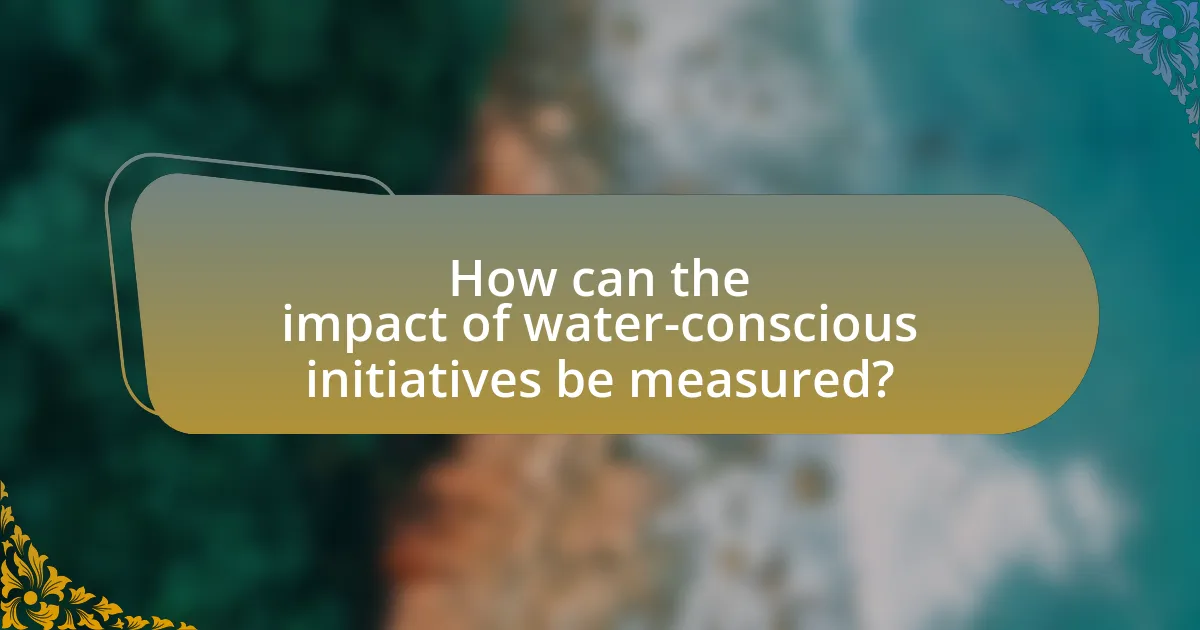
How can the impact of water-conscious initiatives be measured?
The impact of water-conscious initiatives can be measured through quantitative metrics such as water usage reduction, cost savings, and community engagement levels. For instance, municipalities can track changes in water consumption before and after implementing conservation programs, revealing a percentage decrease in usage that directly correlates with the initiative. Additionally, financial assessments can show cost savings on water bills, providing a clear economic incentive for participation. Surveys and participation rates in community events can also gauge engagement, indicating the initiative’s effectiveness in raising awareness and fostering a culture of conservation.
What metrics can be used to assess water conservation efforts?
Metrics used to assess water conservation efforts include water usage reduction, cost savings, and water quality improvements. Water usage reduction can be quantified by measuring the decrease in gallons of water consumed over a specific period, often expressed as a percentage compared to previous usage levels. Cost savings can be calculated by analyzing the reduction in water bills resulting from conservation measures, providing a financial incentive for communities to engage in water-saving practices. Water quality improvements can be assessed through testing for contaminants and measuring changes in parameters such as turbidity and pH levels, indicating the effectiveness of conservation strategies in maintaining or enhancing the health of local water sources. These metrics provide concrete evidence of the impact of water conservation initiatives on both resource management and community engagement.
How can community surveys provide insights into water usage habits?
Community surveys can provide insights into water usage habits by collecting data directly from residents about their consumption patterns, preferences, and behaviors. These surveys often include questions regarding daily water use, sources of water, and attitudes towards conservation, allowing for a comprehensive understanding of how water is utilized within the community. For instance, a survey conducted in 2021 by the American Water Works Association revealed that 70% of respondents were unaware of their household water usage, highlighting a gap in knowledge that can inform educational initiatives. By analyzing the responses, local authorities can identify trends, target specific areas for conservation efforts, and develop tailored programs that promote sustainable water practices.
What role does data collection play in evaluating conservation success?
Data collection is essential for evaluating conservation success as it provides measurable evidence of ecological changes and the effectiveness of conservation strategies. By systematically gathering data on species populations, habitat conditions, and water quality, conservationists can assess the impact of their initiatives. For instance, a study published in the journal “Ecological Applications” demonstrated that data collection on fish populations in restored wetlands led to a 30% increase in biodiversity, indicating successful conservation efforts. This empirical evidence allows stakeholders to make informed decisions, adapt strategies, and allocate resources effectively, ultimately enhancing the overall success of conservation programs.
How can feedback from community members improve water conservation strategies?
Feedback from community members can significantly enhance water conservation strategies by providing insights into local needs and behaviors. Engaging community members allows for the identification of specific water usage patterns and challenges that may not be apparent to policymakers. For instance, surveys and focus groups can reveal preferences for certain conservation methods, leading to tailored initiatives that resonate with residents. Research indicates that communities with active participation in conservation efforts see a 20-30% increase in water-saving behaviors, as noted in studies by the American Water Works Association. This direct involvement fosters a sense of ownership and accountability, ultimately leading to more effective and sustainable water conservation practices.
What methods can be used to gather community feedback effectively?
Surveys and questionnaires are effective methods for gathering community feedback. These tools allow for the collection of quantitative data from a large number of participants, enabling the identification of trends and common concerns. According to a study published in the Journal of Community Engagement and Scholarship, surveys can yield response rates of 30-50% when designed effectively, providing a solid basis for understanding community perspectives. Additionally, focus groups facilitate in-depth discussions, allowing participants to express their thoughts and feelings in a more nuanced manner. Research indicates that focus groups can uncover insights that surveys may miss, as they encourage interaction and elaboration among participants. Furthermore, community meetings and public forums create opportunities for direct engagement, fostering a sense of ownership and involvement among community members. These methods collectively enhance the quality and depth of feedback, ensuring that community voices are heard and considered in decision-making processes.
How can success stories be shared to inspire further action?
Success stories can be shared to inspire further action by utilizing various communication channels such as social media, community events, and newsletters. These platforms allow for the dissemination of impactful narratives that highlight the positive outcomes of water conservation efforts, thereby motivating others to participate. For instance, a study by the Water Research Foundation found that communities that shared success stories experienced a 20% increase in participation in water-saving programs. This demonstrates that effective storytelling not only informs but also engages and encourages community members to take action.
What are some best practices for sustaining a water-conscious community culture?
Best practices for sustaining a water-conscious community culture include implementing educational programs, promoting water-saving technologies, and encouraging community engagement in conservation efforts. Educational programs raise awareness about water scarcity and efficient usage, leading to informed decision-making among residents. For instance, communities that have adopted school-based water education initiatives report a significant increase in water conservation behaviors among students and their families. Promoting water-saving technologies, such as low-flow fixtures and rainwater harvesting systems, can reduce overall water consumption; studies show that households using these technologies can save up to 30% on water bills. Lastly, fostering community engagement through events like water conservation challenges or clean-up days can strengthen collective responsibility and commitment to sustainable practices, as evidenced by communities that have successfully reduced water usage through collaborative efforts.
How can ongoing education and outreach maintain community engagement?
Ongoing education and outreach can maintain community engagement by providing continuous access to information and resources that empower residents to participate actively in water conservation efforts. Regular workshops, informational sessions, and community events foster a sense of belonging and shared responsibility among community members. Research indicates that communities with consistent educational initiatives see a 30% increase in participation in conservation programs, as residents feel more informed and motivated to contribute. Additionally, outreach efforts that utilize local success stories and data create relatable narratives, enhancing community members’ connection to the cause and encouraging sustained involvement.
What strategies can ensure long-term commitment to water conservation?
Long-term commitment to water conservation can be ensured through education, community engagement, and policy implementation. Education initiatives, such as workshops and school programs, raise awareness about the importance of water conservation and its impact on the environment. Community engagement fosters a sense of ownership and responsibility, encouraging residents to participate in local conservation efforts, such as clean-up events and water-saving challenges. Policy implementation, including incentives for water-efficient appliances and regulations on water usage, creates a structured framework that supports sustainable practices. Research shows that communities with strong educational programs and active participation in conservation efforts experience a significant reduction in water usage, reinforcing the effectiveness of these strategies.

